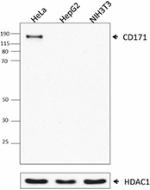- Clone
- L1-OV198.5 (See other available formats)
- Regulatory Status
- RUO
- Other Names
- CAML1, HSAS, HSAS1, MASA, MIC5, N-CAM-L1, N-CAML1, S10, SPG1, L1CAM, Neural cell adhesion molecule L1
- Isotype
- Mouse IgG2a, κ

-

Human M21 cell line was stained with CD171 (clone L1-OV198.5) Alexa Fluor® 647 (filled histogram) or mouse IgG2a, κ isotype control (clone MOPC-173) Alexa Fluor® 647 (open histogram). -

Human paraffin-embedded colon tissue slices were prepared with a standard protocol of deparaffinization and rehydration. Antigen retrieval was done with Citrate Buffered 1X (10mM, pH6.0) at 95°C for 40 minutes. Tissue was washed with PBS/0.05% Tween 20 twice for five minutes, permeabilized with PBS with 0.5% Triton X-100 and blocked with 5% FBS and 0.2% gelatin for 30 minutes. Then, the tissue was stained with 10µg/mL of Alexa Fluor® 594 anti-Vimentin (clone O91D3) antibody (green) and Alexa Fluor® 647 anti-CD171 (clone L1-OV198.5) antibody (red) over night at 4°C. Nuclei were counterstained with DAPI (blue). The image was scanned with a 10X objective and stitched with MetaMorph® software.
| Cat # | Size | Price | Quantity Check Availability | ||
|---|---|---|---|---|---|
| 371607 | 25 µg | $159.00 | |||
| 371608 | 100 µg | $405.00 | |||
CD171, also known as L1CAM or L1, is a transmembrane glycoprotein. It is a 200-220 kD neuronal cell adhesion molecule and a member of the L1 protein family belonging to the immunoglobulin superfamily.
This cell adhesion molecule plays an important role in nervous system development, including neuron-neuron adhesion, signal transduction, axon guidance, cell migration and differentiation. CD171 also has a strong implication in treatment-resistanct cancers. Mutations in the gene cause three X-linked neurological syndromes known by the acronym CRASH (corpus callosum hypoplasia, retardation, aphasia, spastic paraplegia and hydrocephalus). Alternative splicing of a neuron-specific exon is thought to be functionally relevant.
Product Details
- Verified Reactivity
- Human
- Antibody Type
- Monoclonal
- Host Species
- Mouse
- Immunogen
- SKOV-3 ovarian carcinoma cells.
- Formulation
- Phosphate-buffered solution, pH 7.2, containing 0.09% sodium azide.
- Preparation
- The antibody was purified by affinity chromatography and conjugated with Alexa Fluor® 647 under optimal conditions.
- Concentration
- 0.5 mg/ml
- Storage & Handling
- The antibody solution should be stored undiluted between 2°C and 8°C, and protected from prolonged exposure to light. Do not freeze.
- Application
-
FC - Quality tested
IHC-P - Verified - Recommended Usage
-
Each lot of this antibody is quality control tested by immunofluorescent staining with flow cytometric analysis. For flow cytometric staining, the suggested use of this reagent is ≤0.5 µg per million cells in 100 µl volume. For immunohistochemistry, a concentration range of 5.0 - 10 µg/ml is suggested. It is recommended that the reagent be titrated for optimal performance for each application.
* Alexa Fluor® 647 has a maximum emission of 668 nm when it is excited at 633 nm / 635 nm.
Alexa Fluor® and Pacific Blue™ are trademarks of Life Technologies Corporation.
View full statement regarding label licenses - Excitation Laser
-
Red Laser (633 nm)
- RRID
-
AB_2734424 (BioLegend Cat. No. 371607)
AB_2734424 (BioLegend Cat. No. 371608)
Antigen Details
- Structure
- 200-220 kD. Several immunoglobulin-like domains and fibronectin-like repeats (type III), linked via a single transmembrane sequence to a conserved cytoplasmic domain.
- Distribution
-
Tetanus-toxin positive neurons, endothelial cells, certain epithelial cells, reticular fibroblasts, colon and breast carcinomas, colon melanoma, tumor cells of neuronal and mesothelial origin.
- Function
- Adhesion molecule. Homotypic and heterotypic cell-cell interaction in neuronal myelination, neurite outgrowth and regeneration. Axonal guidance, neuronal migration.
- Ligand/Receptor
- Homophilic interaction with itself and heterophilic binding to integrins, other cell adhesion molecules, extracellular matrix molecules.
- Cell Type
- Endothelial cells, Epithelial cells, Fibroblasts, Neurons
- Biology Area
- Cancer Biomarkers, Cell Adhesion, Cell Biology, Immunology, Neuroscience, Synaptic Biology
- Molecular Family
- Adhesion Molecules, CD Molecules
- Antigen References
-
1. Wolterink S, et al. 2010. Cancer Res. 70(6):2504.
2. Huszar M, et al. 2006. Human Pathology 37(8):1000.
3. Kaifi JT, et al. 2006. Anticancer Res. 26(2A):1167.
4. Kaifi JT, et al. 2006. Mod. Pathol. 3:399.
5. Meier F, et al. 2006. Int. J. Cancer 119(3)549.
6. Stoeck A, et al. 2006. Biochem. J. 393:609.
7. Gutwein P, et al. 2005. Clin. Cancer Res. 11(7)2492. - Gene ID
- 3897 View all products for this Gene ID
- UniProt
- View information about CD171 on UniProt.org
Other Formats
View All CD171 (L1CAM) Reagents Request Custom Conjugation| Description | Clone | Applications |
|---|---|---|
| Purified anti-human CD171 (L1CAM) | L1-OV198.5 | FC,ICC,WB,IHC-F,IHC-P |
| PE anti-human CD171 (L1CAM) | L1-OV198.5 | FC |
| Alexa Fluor® 647 anti-human CD171 (L1CAM) | L1-OV198.5 | FC,IHC-P |
| TotalSeq™-C0430 anti-human CD171 (L1CAM) | L1-OV198.5 | PG |
| TotalSeq™-B0430 anti-human CD171 (L1CAM) | L1-OV198.5 | PG |
Compare Data Across All Formats
This data display is provided for general comparisons between formats.
Your actual data may vary due to variations in samples, target cells, instruments and their settings, staining conditions, and other factors.
If you need assistance with selecting the best format contact our expert technical support team.
-
Purified anti-human CD171 (L1CAM)
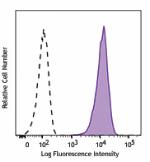
M21 cells were stained with purified CD171 (clone L1-OV198.5... 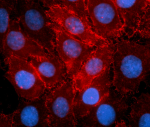
HeLa cells were fixed with 2% PFA for 10 minutes, permeabili... Total cell lysates (15 µg protein) from HeLa, HepG2 and NIH3... -
PE anti-human CD171 (L1CAM)
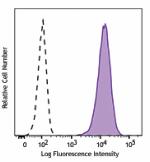
M21 cells were stained with CD171 (clone L1-OV198.5) PE (fil... -
Alexa Fluor® 647 anti-human CD171 (L1CAM)
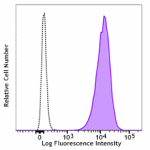
Human M21 cell line was stained with CD171 (clone L1-OV198.5... 
Human paraffin-embedded colon tissue slices were prepared wi... -
TotalSeq™-C0430 anti-human CD171 (L1CAM)
-
TotalSeq™-B0430 anti-human CD171 (L1CAM)

